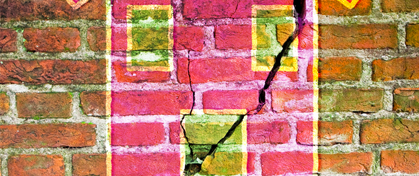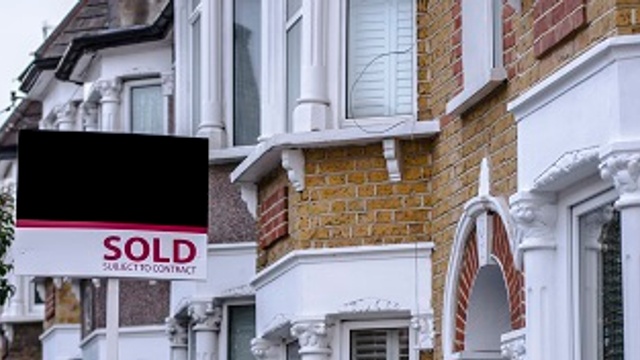There’s something about old houses that really appeals to us. Perhaps it’s the character features they’re packed with, or the knowledge that they’ve provided a home to families going back generations.
However, older properties, and particularly those built up to the end of the Victorian era, also come with their share of risks. It’s easy for the heart to lead the head when buying a property, but if you’ve got your eye on an older building, here’s some potential risks to keep in mind.

Cracks/subsidence
Victorian and Edwardian homes can, unfortunately, be at greater risk of subsidence than newer properties as they tend to have shallower foundations. Properties built on clay can also be at an increased risk, because the substance has a tendency to expand when wet and shrink when dry, and this movement puts a strain on the foundations. Another cause is nearby trees, which may drink up the moisture in the soil beneath your home.
Subsidence occurs when the ground stops providing as much support, causing the foundations to sink. You may not notice that the property is on a slant, but signs that you have subsidence include your windows or doors sticking or cracks forming in the walls.
If you’re planning to purchase an older home and there are signs of subsidence, you should get it checked out by a professional. There’s a chance the cracks are caused by settlement, which isn’t a cause for alarm – and a professional will be able to tell the difference. Read our blog to find out more about subsidence, and whether it should prompt you to walk away from a house you are planning to buy.
Damp and mould
Damp and mould are caused by moisture getting into a property. Unfortunately, older buildings can be at particular risk as they may lack the damp proof courses and roof felting that newer homes include. And if the property has been left empty for an extended period of time, this can also add to the problem.
Signs of damp include the appearance of mould on the walls and ceiling, stained or crumbling woodwork like skirting boards, dark patches on the walls or ceiling that get darker when it rains, rusting nails in the woodwork, peeling wallpaper and crumbling mortar on the outside of the home. Even if you can’t see these signs, if a property smells musty it could be a warning you have a damp problem.
Damp can be fixed. However, one of the most common fixes is a chemical damp proof course, and this isn’t always suitable for older homes. You’re best having a damp and timber survey carried out to find out if you have a problem and what you can do to fix it, before working out whether the work is possible or will cost too much.

Dangerous substances
This is perhaps the greatest risk to be aware of when planning to buy an older home. The two most dangerous substances to look out for are asbestos and lead, both of which were commonly used in the construction of properties up until relatively recently. Asbestos can be found in properties built up to 2000, and lead paint stopped being sold to the public in 1992.
Asbestos has been linked to fatal lung cancer and other lung disease. It is not dangerous unless it’s disturbed and the fibres become airborne. It can be found in ceiling tiles, boilers and insulation, among other things. If you think it’s somewhere in your home, never touch it but contact a professional, your local council or the Health and Safety Executive for more information.
Lead is also only really a problem if it’s disturbed, so if you think it’s present in your home, don’t touch it. It is a toxic substance, and presents a particular danger to children and pregnant women. Health problems caused by lead include anaemia, stomach and head pain, infertility, kidney and nerve damage. You can find out more about lead in the home here.
We’re not saying you should let the possible presence of dangerous substances put you off buying an older home, but it is a risk about which you should be aware.
Electrical wiring
The fact is, electricity simply wasn’t present in the home prior to Victorian times so properties built before this will not have been designed with wiring in mind. Plus, our reliance on electrical power has grown so much that even those that are wired may not meet the needs of the modern household.
In fact, if your wiring is over 25 years old you should make it a priority to get it checked and see if it needs replacing. And if you’re planning to buy the property, make sure you get a home survey (either a RICS Condition or HomeBuyer Report) as this will include information on the wiring and whether it needs to be replaced.
Make no mistake, faulty wiring can present a significant risk to your safety. Electricity is one of the leading causes of accidental fires in the home. If you discover that the older house you’re thinking of buying needs to be rewired, try and get the work done as soon as possible. It can be an expensive job and also a disruptive one as it often involves the pulling up of floorboards and removal of skirting boards, so if possible it’s a good idea to get the work done before you move in.

Poor energy rating
Buying a home with a low energy rating isn’t dangerous – but it comes with a financial risk. Older houses are notorious for not being the best energy performers, which is no surprise considering they were built before things like central heating and double glazing became the standard.
Among the things that can attract buyers to Victorian homes are the wide ceilings and ornate fireplaces. However, the flipside is that they can be draughty and take longer to heat. Attractive features like stained glass window panels have the downside of being single glazed and letting hot air escape. And timber-frame buildings can be difficult to insulate.
So while it might be a building’s period features that attract you to it, they can also mean your energy bills will be quite high and your Energy Performance Certificate (EPC) rating quite low. As EPCs are required when you sell your home, there’s a chance that a low rating could put off buyers – and you must keep this in mind if you’re thinking of buying a property with a poor EPC rating.
Expensive insurance
Historic properties can be more expensive to insure because, if they were to be damaged, you may need to hire an expert to carry out the repairs or pay for specialist materials to ensure the character of the property is not lost. You may need non-standard buildings insurance to make sure you’re covered, but there’s a smaller market of lenders offering this, which means your choice is limited and you may have to pay more.
Features that would mark out the home you’re thinking of buying as non-standard include wattle and daub, timber frame and flint or thatched roofs. If the property is listed, it could also be more expensive to insure – and you’ll have to apply for consent if you want to make any changes to the property.
The UK is lucky to be home to a wealth of beautiful old buildings, some of which date back centuries. We hope this guide hasn’t prompted you to abandon your dream of owning one, but has helped fill you in on some of the risks to be aware of when you make an offer. After all, you may be able to use the information to negotiate with the seller and get a better deal.
Disclaimer: We make every effort to ensure content is correct when published. Information on this website doesn't constitute financial advice, and we aren't responsible for the content of any external sites.








